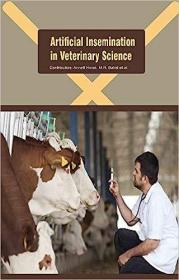
现货Artificial Insemination in Veterinary Science[9781785696572]
¥ 1594 九五品
仅1件
上海宝山
认证卖家担保交易快速发货售后保障
作者Annett Heise, M.R. Bakst et al.
出版社Koros
ISBN9781785696572
出版时间2019-03
装帧精装
纸张其他
页数348页
正文语种英语
上书时间2023-08-08
- 最新上架
商品详情
- 品相描述:九五品
- 商品描述
- artificial insemination (ai) is a technique in which sperm are collected from the male, processed, stored and artificially introduced into the female reproductive tract at proper time for the purpose of conception. in production animals, ai is a way to increase reproductive efficiency and production. ai has proven to be a very effective reproductive technology that selectively increases genetic gain through increased selection pressure on males. in holstein cattle, for example, ai supported selection for the milk production trait and within 40 years milk production has nearly doubled. farm animals, males as well as females, are usually chosen for breeding programs based on breeding soundness examinations (bses). these bses determine suitability and likelihood of females or males to participate successfully in breeding programs. animals that do not fulfill certain criteria are identified. artificial insemination (ai) was the first assisted reproductive technique applied to control and improve reproduction as well as genetics. this volume covers the state of the art methods and techniques in artificial insemination in veterinary. ai has become one of the most important techniques ever devised for the genetic improvement of farm animals. it has been most widely used for breeding dairy cattle and buffalo. understanding basic anatomy and reproductive physiology of sheep and goats is important in implementing appropriate reproductive management. ai has been used in the majority of domestic species, including bees, and also in human beings. it is the most commonly used art in livestock, revolutionizing the animal breeding industry during the 20thcentury. ai is by far the most common method of breeding intensively kept domestic livestock, such as dairy cattle, pigs and turkeys. ai is increasing in horses, beef cattle and sheep, and has been reported in other domestic species such as dogs, goats, deer and buffalo. it has also been used occasionally in conservation breeding of rare or endangered species, for example, primates, elephants and wild felids. reproduction is an important consideration in the economics of cattle production. in the absence of regular breeding and calving at the appropriate time, cattle rearing will not be profitable. a healthy calf each year is the usual goal. this is possible only by increasing the reproductive efficiency of the animals. this time saw major advances such as the development of artificial vaginas and phantoms for semen collection. reproductive management, comprising of detection of estrus, mating, identifying pregnant animals, care of pregnant animals, care at parturition and care of the male, plays a major role in the profitability of a sheep or goat farm. artificial insemination is practiced extensively with commercial turkeys. this is primarily the result of selective breeding for a heavier and broader-breasted commercial turkey and the consequent inability of toms to consistently transfer semen to the hen at copulation. the broiler industry has not adapted ai to the extent of the turkey industry but it is occasionally used in pedigree lines and in regions where labor is relatively cheap. this volume covers technique represents a breakthrough in species conservation programs and will enable future research into the ecology and environmental factors influencing endangered species. ...
— 没有更多了 —
![现货Artificial Insemination in Veterinary Science[9781785696572]](https://www0.kfzimg.com/sw/kfz-cos/kfzimg/17733071/3c49c43494447df5_b.jpg)

![现货Materials and Technologies of Modern Production[9783036401683]](https://www0.kfzimg.com/sw/kfz-cos/kfzimg/17733071/5fd2824531e165d7_s.jpg)
![现货Introduction to Container Ship Operations and Onboard Safety[9781032155425]](https://www0.kfzimg.com/sw/kfz-cos/kfzimg/17733071/58b7ff43ef7909ee_s.jpg)
![现货Electrophosphorescent Materials and Devices[9789814877343]](https://www0.kfzimg.com/sw/kfz-cos/kfzimg/17733071/18cc1d77bcb7b488_s.jpg)
![现货Organic Semiconductors for Optoelectronics[9781119146100]](https://www0.kfzimg.com/sw/kfz-cos/kfzimg/17733071/24c85a750c708964_s.jpg)
![现货Advances in Food Rheology and Its Applications[9780081004319]](https://www0.kfzimg.com/sw/kfz-cos/kfzimg/17733071/e0c11603c9119d4d_s.jpg)
![现货Advanced Materials and Sustainable Technologies[9783035727562]](https://www0.kfzimg.com/sw/kfz-cos/kfzimg/17733071/dced675333874c48_s.jpg)
![现货Advanced Materials and Manufacturing Engineering II[9783035712681]](https://www0.kfzimg.com/sw/kfz-cos/kfzimg/17733071/660ccfae75fa8d3e_s.jpg)
![现货Materials in Machinery and Construction[9783035718119]](https://www0.kfzimg.com/sw/kfz-cos/kfzimg/17733071/6f402060775e9daa_s.jpg)
![现货Cereal Grain Quality (Softcover Reprint of the Original 1st 1996)[9789401071772]](https://www0.kfzimg.com/sw/kfz-cos/kfzimg/17733071/f93ca1c96a97403a_s.jpg)
![现货Artificial Insemination in Veterinary Science[9781785696572]](/dist/img/error.jpg)
以下为对购买帮助不大的评价